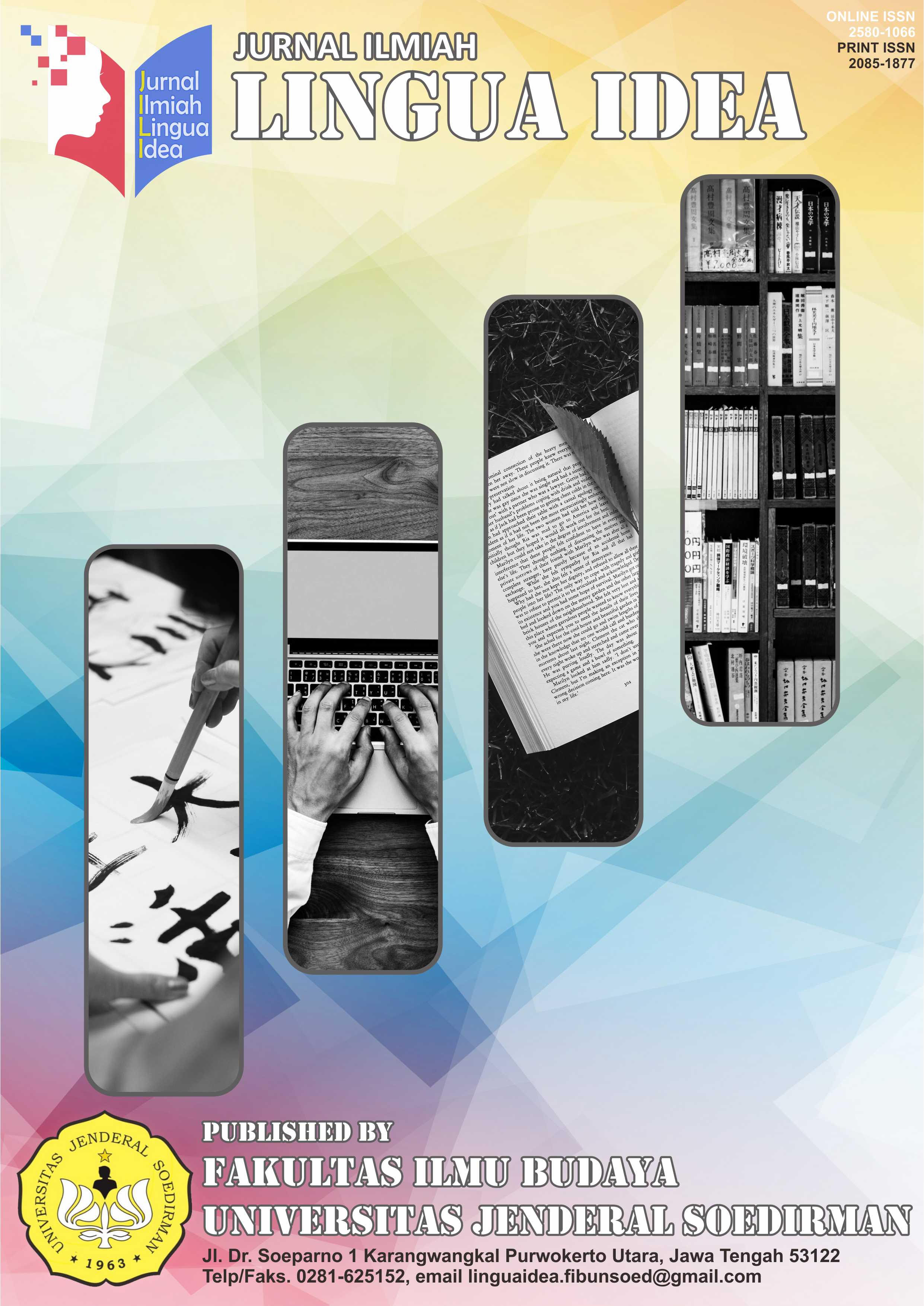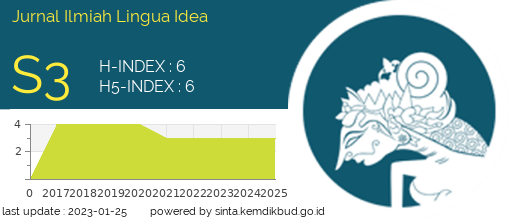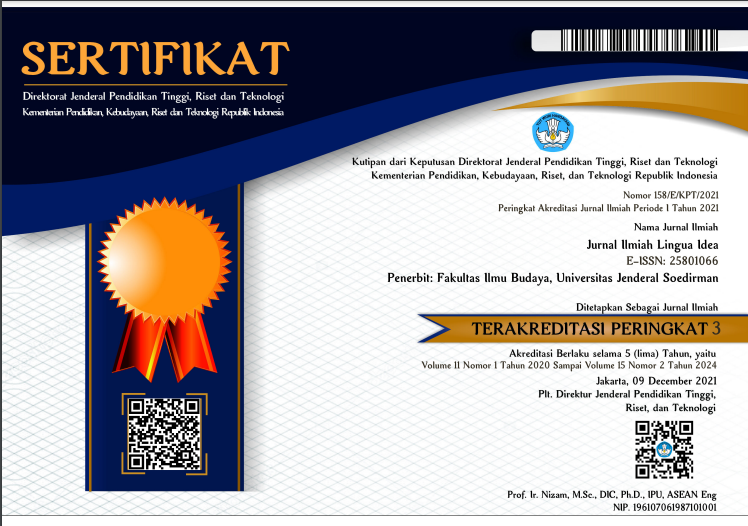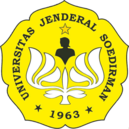Beyond Anpanman the (Super)hero: Investigating Figures of Hero and Idol in BTS’s Songs
Abstract
Released in May 2018, the song “Anpanman” by the world’s most popular K-Pop boy group to date, BTS, shares the idea of being a hero by setting an example from the Japanese superhero Anpanman. Anpanman, whose head is made of red bean paste-filled pastry, is well-known for his superpower ability to share parts of his head to those in need. This humble and self-sacrifice mode of helping others seems to be the basic idea of the song, to represent what BTS is about. This essay aims to further dissect the song lyrics of “Anpanman” to show the ambivalence presented between the concept of hero and superhero (termed here as (super)hero). The discussion goes further to juxtaposing the concept of hero/superhero with idol, a term used as another one of BTS’s songs “Idol”. Considering that in K-Pop, being an idol is practically a dream job, it is therefore paramount that in discussing the songs, this essay highlights the paradox of what it means to be a hero/superhero with an idol. Within the frame of network analysis, the discussion is conducted specifically along the line of the effects that digital culture has, which helps the spreading of BTS’s popularity and persona globally. In this light, this essay argues that beyond the songs, a problematic view on what it means to be a hero and an idol is projected. Ultimately, the discussion concludes that such an ambivalent view potentially leads to a reconceptualization of a superhero figure.Released in May 2018, the song “Anpanman” by the world’s most popular K-Pop boy group to date, BTS, shares the idea of being a hero by setting an example from the Japanese superhero Anpanman. Anpanman, whose head is made of red bean paste-filled pastry, is well-known for his superpower ability to share parts of his head to those in need. This humble and self-sacrifice mode of helping others seems to be the basic idea of the song, to represent what BTS is about. This essay aims to further dissect the song lyrics of “Anpanman” to show the ambivalence presented between the concept of hero and superhero (termed here as (super)hero). The discussion goes further to juxtaposing the concept of hero/superhero with idol, a term used as another one of BTS’s songs “Idol”. Considering that in K-Pop, being an idol is practically a dream job, it is therefore paramount that in discussing the songs, this essay highlights the paradox of what it means to be a hero/superhero with an idol. Within the frame of network analysis, the discussion is conducted specifically along the line of the effects that digital culture has, which helps the spreading of BTS’s popularity and persona globally. In this light, this essay argues that beyond the songs, a problematic view on what it means to be a hero and an idol is projected. Ultimately, the discussion concludes that such an ambivalent view potentially leads to a reconceptualization of a superhero figure.
References
BANGTANTV. (2020, 23 Sep). BTS (방탄소년단) Speech at the 75th UN General Assembly. URL https://www.youtube.com/watch?v=5aPe9Uy10n4.
Cawelti, J. G. (2013). “Literary Formulas”. In Charles Hatfield, Jeet Heer, and Kent Worcester (Eds.), The Superhero Reader. U.S.A.: University Press of Mississippi: 78-79.
Coogan, P. (2013). “Comics Predecessors”. In Charles Hatfield, Jeet Heer, and Kent Worcester (Eds.), The Superhero Reader. U.S.A.: University Press of Mississipi: 7-15.
Elberse, A & Woodham, L. (2020). Big Hit Entertainment and Blockbuster Band BTS: K-Pop Goes Global. Harvard Business School Case 520-125, June 2020.
Fairclough, N. (1995). Critical Discourse Analysis: The Critical Study of Language. London and New York: Longman.
Fureeberukan. Konnichiwa Anpanman: Yanase Takashi Sensei Arigatou Gozaimashita. URL https://www.froebel-kan.co.jp/anpanman/.
Fureeberukan. ’Anpanman (hiragana)’ to ‘Anpanman (katakana)’. URL https://www.froebel-kan.co.jp/anpanman/history.html.
Gomez, A. (2018). “How Japan Adopted the Superhero”. Big Shiny Robot. URL https://bigshinyrobot.com/anime/how-japan-adopted-superhero/ [Accessed: March 28]
Gray, I. I., Richard J., Kaklamanidou, B. (2011). “Introduction”. In Richard J. Gray II and Betty Kaklamanidou (Eds.), The 21st Century Superhero Essays on Gender, Genre and Globalization in Film. Jefferson: McFarland & Company, Inc., Publishers: 1-14.
Hatfield, C., Heer, J., Worcester, K. (2013). “Historical considerations”. In Charles Hatfield, Jeet Heer, and Kent Worcester (Eds.), The Superhero Reader. U.S.A.: University Press of Mississipi: 3-6.
Harrison, G. P. (2017). Think before You Like: Social Media’s Effect on the Brain and the Tools You Need to Navigate Your Newsfeed. New York: Prometheus Books.
Hong, E. (2014). The Birth of Korean Cool: How One Nation is Conquering the World through Pop Culture. New York: Picador.
Ito, M. (2007). “Technologies of the Childhood Imagination: Yu-Gi-Oh!, Media Mixes, and Everyday Cultural Production”. In Joe Karaganis (Ed.), Structures of Participation in Digital Culture. New York: Social Science Research Council: 88-111.
Jaeguchi. (2018). BTS (방탄소년단)-ANPANMAN (Color Coded Lyrics). URL https://www.youtube.com/watch?v=pWVtB0ZNn0w. [Accessed: May, 18]
Kress, G. (2010). Multimodality: A Social Semiotic Approach to Contemporary Communication. New York: Routledge.
Lee, S., & Nornes, A. (Eds.). (2015). Hallyu 2.0: The Korean Wave in the Age of Social Media. Ann Arbor: University of Michigan Press. Retrieved September 27, 2020, from http://www.jstor.org/stable/10.3998/mpub.7651262.
Lewis, A. D. (2014). American Comics, Literary Theory, and Religion: The Superhero Afterlife. New York: Palgrave MacMillan.
Manggong, L. (2018). Differences and performativity: Theorizing Bangtan Sonyeondan (BTS)’s construction of popularity through Snow White and the Seven Dwarfs. Unpublished paper.
Manggong, L. (2019). “Membugarkan generasi Z melalui koreografi BTS”. Olahraga dalam Kajian Budaya. Sumedang: Unpad Press, pp. 1-8.
Manggong, L. (2020). “Alih wahana dari video musik dan teasers BTS ke kartun jaringan BTS Save Me sebagai manifestasi budaya digital”. Alih Wahana: Melintas Genre dan Media. Sumedang: Unpad Press, pp. 33-52.
Marinescu, V. (2014). “Many faces of Hallyu in the global world”. In Valentina Marinescu (Ed.), The Global Impact of South Korean Popular Culture Hallyu Unbound. Lanham: Lexington Books, pp. 1-4.
Mnet K-POP. (2018, 24 May). 방탄소년단-ANPANMAN (BTS - ANPANMAN) │BTS COMEBACK SHOW 180524 [Video file]. Retrieved September 27, 2020 from https://www.youtube.com/watch?v=qkLMPihvKaQ
Nugroho, S. A. (2014). “Hallyu in Indonesia”. In Valentina Marinescu (Ed.), The Global Impact of South Korean Popular Culture Hallyu Unbound. Lanham: Lexington Books, pp. 19-32.
Peretti, J. (2007). “Notes on Contagious Media”. In Joe Karaganis (Ed.), Structures of Participation in Digital Culture. New York: Social Science Research Council: 158-163.
Soreike Anpanman. Anpanman no Rekishi. URL https://www.anpanman.jp/sp/about/history.html
Thumim, N. (2012). Self Representation and Digital Culture. U.K.: Palgrave Macmillan.
Van Dijk, T. A. (2015). “Critical Discourse Analysis”. In Deborah Tannen, Heidi E. Hamilton, and Deborah Schiffrin (Eds.). The Handbook of Discourse Analysis (Second Edition). U.K.: Wiley Blackwell: 466-485.
Wrigley, F. (2014). “If the Avengers could have One Japanese Superhero, Who would it be?” Japan Today. URL https://japantoday.com/category/entertainment/if-the-avengers-could-have-one-japanese-superhero-who-would-it-be. [Accessed: December, 16]
Authors who publish with Jurnal Ilmiah Lingua Idea agree to the following terms:
- Authors retain copyright and grant the journal right of first publication with the work simultaneously licensed under a Creative Commons Attribution License (CC BY-SA 4.0) that allows others to share the work with an acknowledgment of the work's authorship and initial publication in this journal.
- Authors are able to enter into separate, additional contractual arrangements for the non-exclusive distribution of the journal's published version of the work (e.g., post it to an institutional repository or publish it in a book), with an acknowledgment of its initial publication in this journal.
- Authors are permitted and encouraged to post their work online (e.g., in institutional repositories or on their website) prior to and during the submission process, as it can lead to productive exchanges, as well as earlier and greater citation of published work.






















.png)






